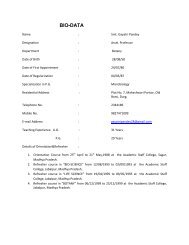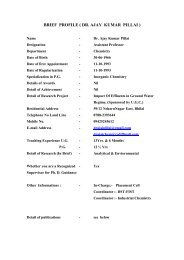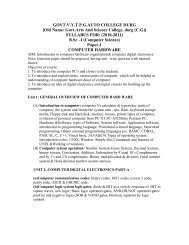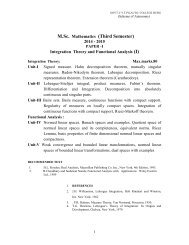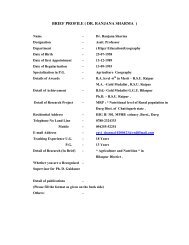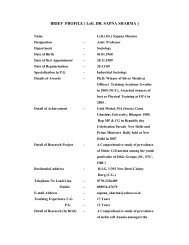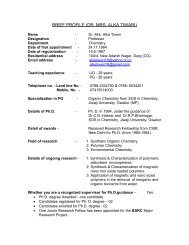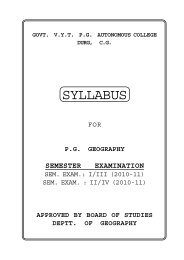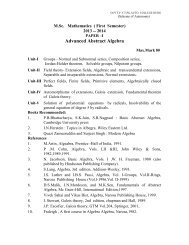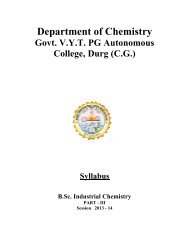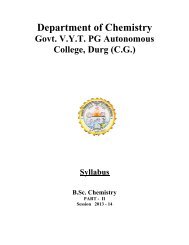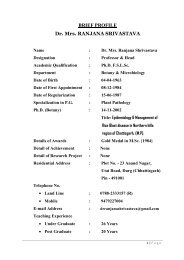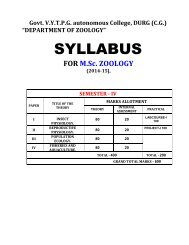M.Sc.(Microbiology) - Govt. V.Y.T.PG. Autonomous College Durg
M.Sc.(Microbiology) - Govt. V.Y.T.PG. Autonomous College Durg
M.Sc.(Microbiology) - Govt. V.Y.T.PG. Autonomous College Durg
Create successful ePaper yourself
Turn your PDF publications into a flip-book with our unique Google optimized e-Paper software.
DEPARTMENT OF MICROBIOLOGYGOVT. V Y T P.G. AUTONOMOUS COLLEGE DURGM.<strong>Sc</strong>. (MICROBIOLOGY) 2010-2011SYALLABUS AND MARKING SCHEME FOR 1 ST SEMESTERFIRST SEMESTERPAPER NO TITLE OF THE MARKS ALLOTED IN TOTALPAPERTHEORY INTERNALASSESMENT1. VIROLOGY. 80 20 1002. FUNDAMENTALSOFIMMUNOLOGY3. MYCOLOGY &PHYCOLOGY4. FOODMICROBIOLOGY80 20 10080 20 10080 20 100
Recommended Books1. A text book of <strong>Microbiology</strong> – P.Chakraborty , New central book agency(P) Ltd.Kolkata.2. General <strong>Microbiology</strong> I & II - C.B. Powar and H. F. Daginawala , HimalayaPublishing House Bombay.3. <strong>Microbiology</strong> – B.D. Davis, R. Dulbecco, H.N. Eisen and H.S. Ginsberg,Harper and Row Publishers Philadelphia.4. Fundamentals of <strong>Microbiology</strong> and Immunology- Ajit Kumar Banerjee andNirmalya Benerjee, New Central book agency (P) Ltd. Kolkata.5. A text book of <strong>Microbiology</strong> – R.C. Dubey and D.K. Maheshwari, S. Chand andCompany Ltd., New Delhi.6. <strong>Microbiology</strong> : Fundamentals and Applications – S.S. Purohit, StudentsEdition, Jodhpur.
M.<strong>Sc</strong>. – MICROBIOLOGYSEMESTER IPAPER – IIFundamentals of ImmunologyUnit - 1 M.M.- 80Immune System and Immunity ; History of Immunology ; Structures,composition and functions of cells and organs involved in immune system; hostparasite relationships; microbial infections; virulence and host resistance;immune responses - innate immunity, acquired immunity; immunohaematology -blood groups, blood transfusion and Rh incompatibilities.Antigens and Antibodies; Antigens - Structure and Properties - types - lso andallo – haptens, adjuvants-antigen specificity.Vaccines and toxoids. Immunoglobulin - structure - heterogeneity - types andsubtypes, properties (physico Chemical and biological).Unit - 2Antigen - antibody Reactions; Theories of antibody production. Complement -Structure - components - properties and functions of complement components;complement Pathways and biological consequences of complementactivativation.Invitro Methods - agglutination, precipitation, complement fixation,immunofluorescence, ELISA, Radio Immunoassays; In vivo Methods; skin tests& immune complex tissue demonstrations applications of these methods indiagnosis of microbial diseases.Unit - 3Major Histocompatibility Complex and Tumor ImmunologyStructure and functions of MHC and the HL-A system. Gene regulation and Irgenes;HL-A and tissue transplantation -Tissue typing methods for organ andtissue transplantations in humans; graft versus host reaction and rejection;autoimmunity - theories, mechanism and diseases with their diagnosis; tumorimmunology-tumor specific antigens, Immune response to tumors,immunodiagnosis of tumors - detection of tumor markers - alphafoetal proteins,carcinoembryonic antigen etc.
Unit - 4Hypersentivity Reactions; Antibody - mediated - Type l. Anaphylaxis; Type II.Antibody dependent cell cytotoxicity; Type III. Immune complex mediatedreactions; Type IV. Cell mediated hypersensitivity reaction. The respectivediseases, immunological methods of their diagnosis. Lymphokines and cytokines- their assay methods.Unit - 5Short answer type questions from above four units. Any two has two beattempted.Recommended Books1. Roitt I.M. (1998) Essentials of Immunology. ELBS, Blackwell <strong>Sc</strong>ientificpublishers, London.2. Kube, J (1994) Immunology II-Edition .W.H. Freeman and company. NewYork.3. Klaus D.Elgert (1996) Immunology. Understanding of Immune System ,Wiley – Liss. NY.4. Topley & Wilson’s (1995) Text book on Principles of Bacteriology, Virologyand Immunology , IX Edi. ( 5 volumes ) Edward Arnold, London.
M.<strong>Sc</strong>. – MICROBIOLOGYSEMESTER IPaper – IIIMycology and PhycologyUnit – 1 M.M. - 80General Features of fungi, Heterothallism, Classification, Structure and celldifferentiation, Division Myxomycota, Mastigomycotina and Zygomycotina,Evolutionary tendencies in lower fungi, Effect of Environment ongrowth,Prevention of fungal growth.Unit – 2Ascomycotina-Hemiascomycetes, Plectomycetes,Pyrenomycetes,Discomycetes,labelbeniomycetes, lculoascomycetes.Basidiomycotina - Teliomycetes, Hymenomycetes.Deuteromycetes - Hypomycetes, Coelomycetes, BlastomycetesEvolutionary trends in higher fungi.Unit – 3Mycorrhiza : Ectomycorrhiza, Endomycorrhiza, Vesicular Arbuscular Mycorrhiza,Fungi as an insect symbiont.Fungal Diseases ; Mycoses systemic and subcutaneous, Pneumocystis,BlastomycosesDermatophytosis, Aspergilosis.Fungi and Ecosystem –Saprophytes, substrate groups and nutritional strategies,substrate successions, fungi and bioremediation, Industrial importance of Fungi.Unit – 4Algae; distribution, classification, nutrition, thallus range, reproduction,pigmentation, blue green algae, green algae, diatoms, euglenoids, algal ecologyand algal biotechnology.Lichens; general account, classification, structure, reproduction and economicimportance.Unit – 5
Short answer type questions from above four units. Any two has two beattempted.Recommended Books1. Mehrotra, R.S. and K.R. Aneja 1990. An Introduction to Mycology.NewAge International publishers.2. Alexopoulus, C.J. and C.W. Mims 1979.Introduvtion to Mycology (3 rd Ed.)Wiley Eastern Ltd.,New Delhi.3. Fundamentals of Mycology, J.H. Burnettm Publisher : Edward , ArnoldCrane russak.4. The Fungi , M.Charlile & S.C. Watkinson, Publisher:Academic Press.5. Fundamentals of Fungi, E. Moore-Landeekeer, Publisher: Prentice Hall.
M.<strong>Sc</strong>. – MICROBIOLOGYSEMESTER IPAPER – IVFood <strong>Microbiology</strong>Unit – 1M.M.-80Food as substrate for microorganisms: Micro organisms important in foodmicrobiology-Molds, Yeasts and Bacteria-General characteristics-classificationand importance. Principles of food preservation. Asepsis – Removal ofmicroorganisms, (anaerobic conditions, high temperatures, low temperature,drying). Factors influencing microbial growth in food –Extrinsic& intrinsic factors;Chemical preservatives and food additives. Canning, processing for Heattreatment - D, Z, and F values and working out treatment parameters.Unit – 2Contamination and Spoilage: Cereals, sugar products, vegetables, fruits, meatand meat products, Milk and Milk products-Fish & sea foods-poultry-spoilage ofcanned foods. Detection of spoilage and characterization.Food-borne infections and intoxications: Bacterial and nonbacterial-withexamples of infective and toxic types- Brucella, Bacillus, Clostridium,Escherichia, Salmonella, Shigella, Staphylococcus, vibrio, Yesinia; Nematodes ,Protozoa , algae , fungi and viruses . Food borne out breaks - laboratory testingprocedures; Prevention Measures - Food sanitation in manufacture and retailtrade ; Food control agencies and its regulations, Plant sanitation-Employee'sHealth standards-waste treatment-disposal-quality control.Unit – 3Food fermentations: bread, cheese, vinegar, fermented vegetables, fermenteddairy products; Experimental and industrial production methods. Spoilage anddefects of fermented dairy products - oriental Fermented foods, their qualitystandards and control.
Unit – 4Food Produced by Microbes: Fermented foods, microbial cells as food (singlecell proteins) - mushroom cultivation. Bioconversions- Production of alcohol-Fermented beverages-beer and wine. Steroid conversions - Industrial Enzymesproductions. Genetically modified foods.Unit – 5Short answer type questions from above four units. Any two has two beattempted.
SECOND SEMESTERPAPER NOTITLE OF THEPAPER5. MOLECULARBIOLOGY6. MICROBIALGENETICS7. MICROBIALPHYSIOLOGY &DEVELPOMENT8. FOODMICROBIOLOGY.MARKS ALLOTED INTHEORY INTERNALASSESMENT80 2080 2080 2080 20
M.<strong>Sc</strong>. – MICROBIOLOGYSEMESTER IIPaper – IMolecular biologyUNIT-1M.M.-80Nucleic acid as genetics information carriers: - experimental evidence. DNAstructure: - Historical aspects and current concepts, melting of DNA. DNAreplication: - generals principles, various modes of replication, isolation andproperties of DNA polymerases, proof reading, continuous and discontinuoussynthesis. Asymmetric and dimeric nature of DNA polymerase III andsimultaneous synthesis of leading and lagging strands. DNA polymerase,exonulease activity in eukaryotic DNA polymerases. Superhelicity in DNA, linkingnumber, topological properties, mechanism of action of topoisomerases.UNIT-2Initiation of replication of single stranded DNA. Construction of replication fork intest tube. Retroviruses and their unique modes of DNA synthesis. Relationshipbetween replication and cell cycle. Inhibitors of DNA replication (blockingprecursor synthesis, nucleotides polymerization, altering DNA structures). DNAdamages and repairs – types of DNA damage (deamination, oxidative damage,alkylation, pyrimidine dimers). Repair pathways – methyl – directed mismatchrepair, very short patch repairs, nucleotide excision repairs, base excisionrepairs, recombination, repairs, and SOS system.UNIT-3Structural features of RNA (rRNA, tRNA and mRNA) and relation to function.Initiators and elongator class of tRNA , ribosome binding sites on mRNA andcorresponding site on rRNA , peptidyl tranferase , steps : - initiation , elongationand termination , inhibitors of RNA synthesis. Polycistronic and monocistronicRNAs. Control of transcription by interaction between RNA polymerases andpromoter regions, use of alternate sigma factors, controlling terminationattenuation and anti termination.
Basic features of genetic codes. Protein synthesis: - steps, details of initiation,elongation, termination, roles of various factors in above steps, inhibitors ofproteins synthesis. Synthesis of exported proteins on membrane boundribosomes, signal hypothesis. In vitro transcription and translation systems.UNIT-4Regulation of genes expression: - operon concept, catabolite repressioninstability of bacterial RNA, positive and negative regulation, inducers and corepressors. Negative regulation- E.coli lac operon, positive regulation – E-coli araoperon, regulation by attenuation – his and trp operons; anti termination – Nprotein and nut sities in I. DNA binding proteins, enhancer sequences andcontrols of transcription. Identification of protein – binding sites on DNA. Globalregulatory responses: - heat shocks response, stringent response and regulationby small molecules such as ppGpp and cAMP regulation of rRNA and tRNAsynthesis.Maturation and processing of RNA: - methylation, cutting and trimming of rRNA,capping, Polyadenylation and splicing of mRNA, cutting and modification of tRNAdegradation system. Catalytic RNA, group I and group II intron splicing RNase P.UNIT- 5Short answer type questions from above four units. Any two has two beattempted.
M.<strong>Sc</strong>. – MICROBIOLOGYSEMESTER IIPaper – IIMicrobial GeneticsUNIT- 1M.M.-80Gene as a unit of mutation,types of mutagens, genetic analysis of mutants, typesof mutations and their origin. Gene as a unit of recombination, molecular natureof recombination.UNIT- 2Gene transfer mechanism; Transformation, Transduction, Conjugation,Transfection , Lysogeny and their applications. Genetic analysis ofmicrobes,Bacteria and Yeast.UNIT- 3Plasmids, types and their uses in genetic analysis, as vector for genecloning,replication of selected plasmids, compatibility. Transposons and theiruses in genetic analysis. Construction of bacterial strains, isolation of mutants.UNIT- 4Genetics of phage; genetic recombination in phages, effect of parental ratio,reciprocity, genetic mapping of phage T4 and other phages, features of T4 lifecycle, T4 gene organization. λ DNA and its genetic organization, life cycle of λ .UNIT- 5Short answer type questions from above four units. Any two has two beattempted.Recommended Books1.Microbial Genetics, Maloy et al. 1994, Jones and Bartlett publishers.2. Modern microbial genetics, Streips and Yasbin ,1991, Niley ltd.3. Microbial gentics, S.R. Maloy, J.E. Cronan, and David Freifelder, Iind edition2006, Narosa publishing house, New Delhi.
M.<strong>Sc</strong>. – MICROBIOLOGYSEMESTER IIPaper – IIIMicrobial Physiology and DevelopmentUNIT- 1 M.M.- 80Basic aspects of bioenergetics - entropy, enthalpy, electrons carrier, artificialelectron donors, inhibitors, uncouplers, energy bond, phosphorylation.Brief account of photosynthetic and accessory pigments-chlorophyll,bacteriochlorophyll, rhodopsin, carotenoids, phycobiliproteins,UNIT - 2Autotrophy, Carbohydrate anabolism, oxygenic & an-oxygenic photosynthesis,autotrophic generation of ATP , fixation of CO2, Calvin cycles, C3-C4pathway,chemolithotrophy, sulphur, iron, hydrogen, nitrogen oxidation , methanogenesis,luminescence.UNIT- 3Respiratory metabolism- Embden Mayer Hoff Parnas pathway, Entner Doudroffpathway, glyoxalate pathway, Krebs cycle, oxidative and substrate levelphosphorylation, reverse TCA cycle, gluconeogenesis, Pasteur effects ,fermentation of carbohydrates, homo and heterolatic fermentation.UNIT- 4Assimilation of nitrogen- dinitrogen, nitrate nitrogen, ammonia, synthesis of majoramino acids – polyamines, synthesis of polysaccharides– peptidoglycanbiopolymersas cell components.Microbial development; cell division, sporulation, endospores-structureproperties, germination, dormancy & morphogenesis. Hyphae vs. yeast forms &their significance.Cellular organisations of Mycoplasma, E. coli, HIV, Protozoa.UNIT- 5Short answer type questions from above four units. Any two has two beattempted.
DEPARTMENT OF MICROBIOLOGYGOVT. V Y T P.G. AUTONOMOUS COLLEGE DURGM.<strong>Sc</strong>. (MICROBIOLOGY) 2010-2011SYALLABUS AND MARKING SCHEME FOR 3 RD SEMESTERTHIRD SEMESTERPAPER NOTITLE OF THEPAPER1. CELLULARMICROBIOLOGYMARKS ALLOTED IN TOTALTHEORY INTERNALASSESMENT80 20 1002. RECOMBINANTDNATECHNOLOGY3. MEDICALMICROBIOLOGY80 20 10080 20 1004. ENVIRONMENTALMICROBIOLOGY.80 20 100
M.<strong>Sc</strong>. – MICROBIOLOGYSEMESTER IIIPAPER – IICellular <strong>Microbiology</strong>Unit - 1M.M.-80Introduction: Emergence of cellular microbiology. Cellular biology underlyingprokaryotic & eukaryotic interaction: ultra structure, genome expression,pathogenicity islands.Cellular microbiology future direction: Comparative genomics & functionalgenomics. Genome evolution in microbes. Phylogenetic trees.Unit - 2Prokaryotic & eukaryotic signaling mechanisms: eukaryotic cell-to-cell signalingendocrine signaling, cylikins prokaryotic signaling: quorum sensing & bacterialpheramones intracellular signalling. Signalling pathways.Unit - 3Infection & cell: cell interaction; bacterial adherence: basic principles, effect ofadhesion on bacteria, effect of adhesion on host cells. Bacterial invasion of hostcells: mechanism, consequence of invasion survival after invasion. Proteintoxins: agents of diseases & examples.Unit - 4Immune response to bacterial infection. Innate response: complement, acutephase proteins, macrophages: cytokines & interferon. Acquired immuneresponse cell mediated immune response, humoral response.Unit - 5Short answer type questions from above four units. Any two has two beattempted.Recommended books1. Cellular <strong>Microbiology</strong> – 1999, Henderson et. Al. Wiley.2. Bacterial genomics – 1998 , De Brujin et. Al. Chapman & Hall.3. Genetics of Bacterial virulence, Dorman C.J. 1994, Blackbell.
M.<strong>Sc</strong>. – MICROBIOLOGYSEMESTER IVPAPER – IIRecombinant DNA TechnologyUnit - 1 M.M.- 80<strong>Sc</strong>ope of Genetic Engineering, Core techniques & essential enzymes used inrDNA technology. Restriction digestion, ligation & transformation. GMO & theirimpact, IPR, Ethical issues regarding rDNA technology.Unit - 2Cloning vectors- Plasmids, types & structures, phages, cosmids vectors, andYAC, BAC. Expression vectors, Promoter probe vectorsUnit - 3Specialized Cloning strategies, cDNA synthesis and cloning, mRNA enrichment ,DNA Primers, Linkers , Adopters and their synthesis. Genomic librabries. Nucleicacid microarrays, Site directed mutagenesis and Protein engineering.Unit - 4PCR , methods & application. DNA sequencing methods; dideoxy & chemicalmethod. Sequence assembly. Automated sequencing. Genome sequencing &physical mapping of genomes. Southern blotting.Unit - 5Short answer type questions from above four units. Any two has two beattempted.
M.<strong>Sc</strong>. – MICROBIOLOGYSEMESTER IIIPAPER – IIIMedical <strong>Microbiology</strong>Unit - 1 M.M.- 80Early discovery of pathogenic microorganisms: development of bacteriology asscientific discipline; contributions made by eminent scientists. Normal microbialflora of human body; role of the resident flora.Classification of pathogenic bacteria, staphylococcus, streptococcus,pneumococcus, Neisseria, Cornebacterium, Bacillus, Clostridium, Non-sporingAnaerobeas, Organisms belonging to Enterobacteriacea, Vibrios, Nonfermenting gram negative bacilli Yersinia; Haemophilus; Bordetella,Brucella;Mycobacteria, Spirochaetes, Anctiomycetes; Rickettsiae, Chlamdiae.Unit - 2Establishment, spreading, tissue damage & anti-phagocytic factors; mechanismof bacterial adhesion, colonization & invasion of mucous membranes ofrespiratory, enteric & urogenital tracts. Role of aggressins, depolymerisingenzymes, organotropisms, variation & virulence. Four lines of defencemachanism.Unit - 3Viruses host interactions; pox viruses; herpes virus, adeno viruses; picarnoviruses; orthomyxo viruses; paramyxo viruses; arbo viruses; rhabdo viruses;hepatitis viruses; oncogenic viruses; human immuno deficiency viruses (AIDS).Dermatophytes, dimorphic fungi, opportunistic fungal pathogens, theirdescription, classification and laboratory diagnosis. Protozoal diseases.Maleria & ameabiosis.Unit - 4Laboratory control of antimicrobial therapy; various methods of drugsusceptibility testing, antibiotic assay in body fluids. Viral vaccines,conventional vaccines, genetic recombinant vaccines used in nationalimmunization programmes with examples, newer generation vaccines including
DNA Vaccines with examples, interferon’s, and antiviral drugs. Nosocomicalinfection, common types of hospital infections , their diagnosis and control.Unit - 5Short answer type questions from above four units. Any two has two beattempted.Recommended Books1. Text book of <strong>Microbiology</strong>, R. Ananthanarayanan and C. K. JayaramPanicker, orient Longman, 1997.2. Mackie and MaCartney, Medical <strong>Microbiology</strong>Vol. 1: Microbial Infection.Vol 2: Practical Medical <strong>Microbiology</strong>.,Churchill Livingstone, 1996.3. <strong>Microbiology</strong> in clinical Practice, D.C. Shanson, Wright PSG, 1982.4. Bailey and <strong>Sc</strong>ott’s Diagnostic <strong>Microbiology</strong>, Baron EJ, Peterson LR andFinegold SM Mosby, 1990.
M.<strong>Sc</strong>. – MICROBIOLOGYSEMESTER IVPAPER – IEnvironmental <strong>Microbiology</strong>Unit - 1M.M.-80Aerobiology: Droplet nuclei, aerosal, assessment of air quality, solid-liquidimpingmentmethods. Brief account of air borne transmission of microbesviruses-bacteria & Fungi, their diseases & preventive measures.Positive & negative roles of microbes in environment: biodegradation ofrecalcitrant compounds-lignin-pesticides; bioaccumulation of metals &detoxification-biopesticides; biodeterioration of paper, leather, wood, textiles,metal corrosion, mode of deterioration, organisms involved, its disadvantages,mode of prevention.Unit - 2Aquatic microbiology: Water ecosystem –types-fresh water (pond, lakes,streams)-marine habitats (estuaries, mangroves, deep sea, hydrothermal vents,saltpans, coralreefs). Zonations of water ecosystems- upwelling–eutrophicationfoodchain. Portability of water-microbial assessment of water quality-waterpurification–brief account of major water borne disease & their control measures.Unit - 3Soil microbiology - Classification of soils-Physical and chemical characteristics,micro flora of various soil types (bacteria & nematodes in relevance to soil types;rhizosphere-phyllosphere-brief account of microbial interactions symbiosismutualism-commensalisms-competition-ammensalism-synergism-parasitismpredation;biogeochemical cycles & the organisms-carbon-nitrogen-phosphorus& sulphur, biofertilisers- biological nitrogen fixation -nitrogenase enzyme, nifgenes, symbiotic nitrogen fixation –(Rhizobium, Frankia)- non symbioticmicrobes- (azotobacter azospirillium- VAM, ecto, endo, ectendomycorrhizaerumenmicrobiology.
Unit - 4Waste Treatment – Wastes- types-solid-liquid wastes characterization-solid andliquid treatments-physical, chemical, biological-aerobic, anaerobic, primary,secondary and tertiary. Solid waste treatment- saccharification -gasificationcomposting,Utilization of solid wastes – food (SCP, mushroom, yeast,): fuel(ethanol, methane) fertilizer (composting), liquid waste treatment-tricklingactivatedsludge-oxidation pond-oxidation ditch. Subterranean microbes &bioremediation.Unit - 5Short answer type questions from above four units. Any two has two beattempted.
FOURTH SEMESTERPAPER NO TITLE OF THE MARKS ALLOTED INPAPERTHEORY INTERNALASSESMENT5. MICROBIAL80 20BIOTECHNOLOGY6. FUNDAMENTALS 80 20OF INFECTION &IMMUNITY7. FERMENTATION 80 20TECHNOLOGY8. PROJECT WORK. 100



